Le contexte de mon client actuel est que le directeur vient de changer et souhaite donner une nouvelle orientation au département. Il a donc déclenché une série de déjeuners avec ses collaborateurs pour apprendre à les connaître et obtenir des propositions d’amélioration. De manière à pouvoir préparer cet entretien, j’ai proposé d’animer un atelier Product Box pour permettre aux personnes de mon plateau de construire ce qui pourrait être, selon eux, la prochaine version de ce département. J’ai eu l’opportunité de co-animer cet atelier avec Gilles Rosenbaum, coach agile chez Goood!. En voici un retour d’expérience.
Qu’est ce que l’atelier Product Box ?
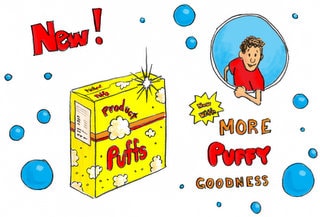
La Product Box est un atelier tiré des innovation games dont l’objectif initial est d’identifier les fonctionnalités les plus passionnantes d’un produit.
On demande aux participants d’imaginer qu’ils vont vendre leur produit dans un salon ou dans un marché. On les invite alors à le matérialiser physiquement sous la forme d’une boite – une boite à chaussures ou à archives généralement – sur laquelle on retrouvera les éléments clés de marketing qu’ils trouveront pertinents à mettre en avant.
Matériel
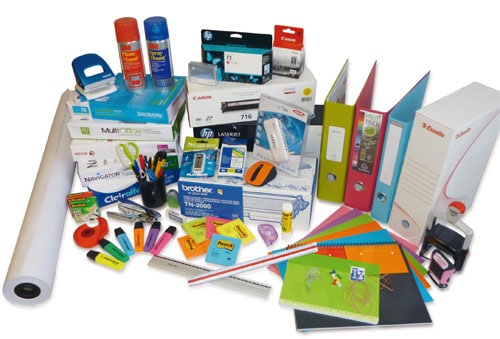
Dans mon cas, voici le matériel mis à disposition des participants :
- Des boites à archives montées à l’envers (pour rendre les boites neutres, sans impression)
- Des feuilles A4 blanches et de différentes couleurs
- Des ciseaux
- Différents types de gommettes
- Des marqueurs de différentes couleurs
- Du scotch simple
- Du scotch de peintre
Note : L’idée est ici de rendre l’atelier ludique et propice à la créativité. Soyez créatif ! 😉
En support pendant l’atelier :
- Une image d’une boite de céréales (Chocapic dans mon cas !)
- Une liste des éléments apparaissant généralement sur une boite de ce type (que je décrirais plus bas)
- Une description de la structure d’un pitch elevator (que je décrirais également plus bas)
Introduire l’atelier
Comme toujours, cette étape est très importante car elle définit le cadre.
J’ai tout d’abord écrit sur une feuille de Paper Board :
Quelle est votre vision de X 2.0 / 3.0 ?
Vendez-là comme un produit !
Note : l’utilisation d’une numérotation de version était issue d’un discours effectué par le nouveau directeur quelques semaines auparavant. Je trouvais cela pertinent de le réutiliser directement.
L’objectif
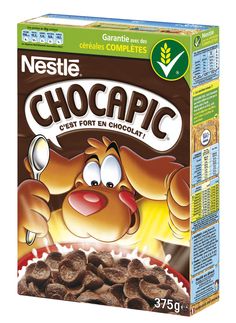
En prenant l’exemple d’une boite de céréales, il était temps de présenter l’objectif de l’atelier.
Votre objectif est de construire votre vision de X 2.0 / 3.0 sous forme d’un produit physique que vous tenterez de vendre aux autres groupes.
Note : L’aspect physique du produit est important. En effet, c’est une manière de concrétiser une idée qui sous forme de feuille volante n’a pas autant de consistance.
Les éléments de la boite
J’ai par la suite décrit quelques éléments de la boîte (sans être prescriptif) :
- Sur le devant :
- Le nom du produit
- Une image
- Un slogan
- Quelques points qui motivent à acheter le produit
- Sur l’arrière :
- Une description plus détaillée du produit
- Sur les côtés :
- Une vue globale des spécifications du produit
Note : La description de ces éléments permet de donner des idées en terme de forme aux participants et de structurer leur phase de production.
Format de l’atelier
Après de nombreuses hésitations, nous avons adopté le format suivant :
- 2 itérations
- 20 mn de production
- 10 mn de feedback entre équipes.
Note : le format itératif permettait aux équipes de pouvoir confronter leurs idées et d’avoir un peu de temps pour faire évoluer leur produit
Pitch elevator

Pour les phases de présentations et feedbacks de 10 mn, j’ai précisé que l’on préférera le format de présentation de type pitch elevator. Pour les personnes ne connaissant pas, j’ai simplement présenté la situation suivante :
Imaginez que vous prenez l’ascenseur avec votre nouveau directeur et que vous n’avez que le temps du voyage pour lui présenter votre produit et mettre en avant ses qualités.
L’exercice n’étant pas évident en tant que tel, j’ai partagé la structure de pitch elevator suivante :
Pour (clients ciblés par le produit)
Qui (besoins principaux)
[Le Produit ] est (nature du produit)
Qui (bénéfices principaux)
A la différence de (pratiques courantes, concurrents)
[Le Produit] (principaux éléments différenciant)
Note : vous l’aurez compris, c’est une manière d’aider les équipes à structurer leurs idées et leurs discours de manière efficace. En effet, l’objectif n’est pas de suivre à la lettre cette formulation mais de ne pas oublier ces éléments dans la réflexion et dans la communication.
Pour terminer, j’ai invité les personnes à s’auto-organiser pour former des sous-groupes équilibrés. Dans mon cas, les 16 personnes ont formé 2 groupes de 5 et un groupe de 6.
Itération 1
Production (20′)
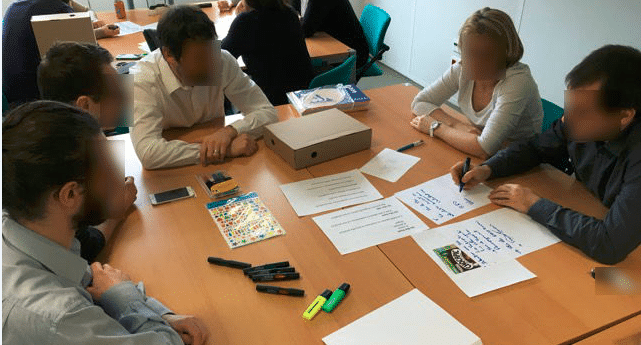
C’est parti pour une première itération de 20 mn. Malgré un départ un petit peu chaotique – les équipes n’ayant pas forcément l’habitude de ce genre d’exercice – la focalisation se porte sur les caractéristiques du pitch elevator.
Au bout d’une dizaine de minutes, aucune équipe n’a commencé à travailler sur sa boite. Je passe alors succinctement leur rappeler que la phase de présentation se fait avec le produit physique et que l’important ici n’est pas d’avoir un produit entièrement fini mais de pouvoir obtenir du feedback : après tout, on sait qu’il y aura une seconde itération ! 😉
Fin de l’itération, premier tour de feedback.
Feedback (10′)
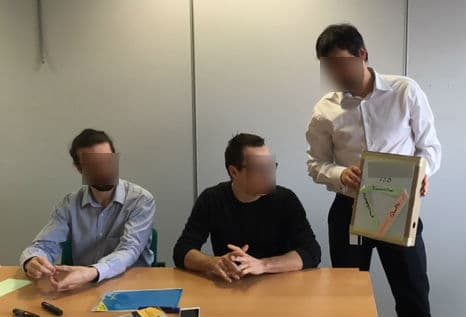
L’animation de cette phase est importante pour garantir la timebox fixée à 10 mn pour 3 groupes.
Pour chaque groupe, mon attention se porte alors sur 3 aspects :
- La présentation de la boite
Je vous invite à présenter aux autres équipes les grandes lignes de votre produit dans leur version actuelle.
Le choix de la première équipe est toujours particulier : le silence règne lorsque l’on demande qui souhaite commencer. Après quelques minutes, les personnes étant habituées au climat bienveillant de ce type d’ateliers, une équipe s’est finalement lancée.
Note : il est important d’instaurer un climat de bienveillance dans ce type d’ateliers lorsqu’un mécanisme de feedback est en jeu. Il aurait pu être pertinent d’afficher et présenter en début de session les règles de fonctionnement comme l’écoute, le respect, la bienveillance…
Mon rôle ici est de faire que les présentations restent succinctes mais suffisamment précises pour pouvoir générer du feedback.
Pour m’assurer que la présentation soit complète, je rajoute toujours ces 2 mots :
Autre chose ?
Puis l’on passe à l’étape suivante.
- La génération de feedback des autres équipes
Après la présentation de la boite, j’invite les autres équipes à donner leurs feedbacks : cela peut être un ressenti, un questionnement, un conseil… tout ce qui pourrait donner des axes de réflexion et d’amélioration.
Lors de ce premier tour de feedback, une remarque intéressante est survenue :
Mais qu’est-ce que ça change par rapport à aujourd’hui ?
En effet, la plupart des valeurs exposées correspondaient déjà à celles actuellement portées par le département. Je me suis tout d’abord permis de valoriser cette remarque avant d’ajouter le fait qu’il était important d’être plus précis sur la mise en oeuvre de chacune de ces valeurs car pour une même valeur, la représentation de chacun peut être très différente !
J’ai alors donné quelques axes de réflexion :
Quels sont les comportements mettant en oeuvre ces valeurs selon vous ?
Qu’est-ce qui fera que les clients achèteront plus votre produit qu’un autre ?
Comment pouvez-vous les faire adhérer à votre vision ? Les faire rêver ?
Pour générer le maximum de feedback, j’ai encore une fois continué avec :
Autre chose ?
- La facilitation des échanges
L’axe principal ici est de s’assurer que les échanges soient les plus efficaces possibles, c’est-à-dire qu’ils atteignent bien l’objectif fixé : permettre à l’équipe ayant présenté sa boite de s’améliorer lors de la prochaine itération.
Note : Pour vérifier que l’objectif est atteint, n’hésitez pas le vérifier. N’oubliez pas que dans cette posture de facilitateur, nous sommes garants du cadre, du processus mais ne sommes pas directement concernés par le contenu. Au lieu de faire des suppositions, il est souvent plus simple de poser directement la question aux personnes concernées ! 😉
Il est donc primordial de bien observer et écouter pour pouvoir intervenir si le sujet commence à déraper ou que l’on rentre dans trop de détails sans valeur (vis à vis de l’objectif).
Note : Cet exercice n’est pas toujours évident, surtout lorsque l’on sent que les personnes se sentent vraiment concernées par le sujet. Il faut alors trouver le juste milieu entre laisser les personnes s’exprimer et les laisser argumenter pendant des heures. Gardez simplement votre objectif en tête : maintenir le cadre, ce qui prend également le respect du temps en compte.
Je termine ensuite par mes 2 mots préférés avant de relancer l’itération suivante. 😉
Réflexion
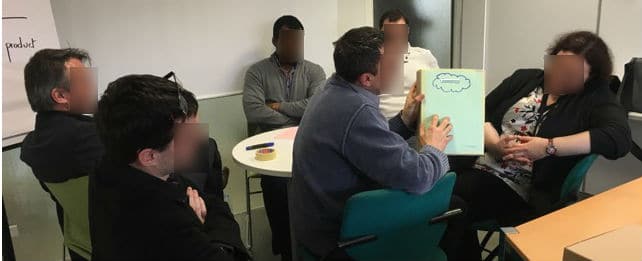
Comme dans la photo présentée ci-dessus, certaines équipes n’ont pas réussi à se sortir à temps de leur modèle de pensée nécessitant d’avoir répondu à tous les critères du Pitch Elevator avant de construire leur boite. Le résultat est qu’ils n’ont pas eu grand chose à présenter lors de la phase de feedback. Ceci est une bonne occasion d’introduire la notion de prototypage et de validation d’hypothèses pas à pas en comparant une mode de production séquentiel à un mode de production itératif.
Itération 2
Production (20′)
La seconde itération lancée, on pouvait déjà sentir les équipes beaucoup plus concentrées. Après ce tour de feedback, elles ont une meilleure idée de la direction à prendre pour leur produit. Il est assez étonnant de voir l’engagement généré par l’activité au sein des différents groupes : les idées fusent, les prototypes également.
Au cours de l’itération, je me permets de passer dans les équipes en leur disant :
- Qu’est ce qui rend votre produit unique ?
- Quels sont les comportements observables différenciants ? (pour les rendre plus concrets)
- Pensez à rester le plus simple possible et à aller à l’essentiel, l’espace de la boite ne permet pas de s’étendre sur des lignes et des lignes.
- Comment allez-vous embarquer les clients avec vous ?
L’itération se termina laissant place au second tour de feedback.
Feedback (10′)
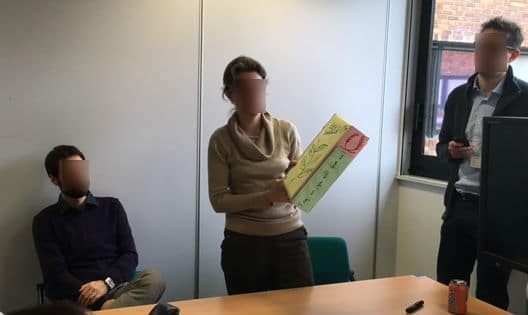
Ce 2ème tour de feedback a été facilité avec brio par Gilles sur le même schéma que précédemment.
Débriefing
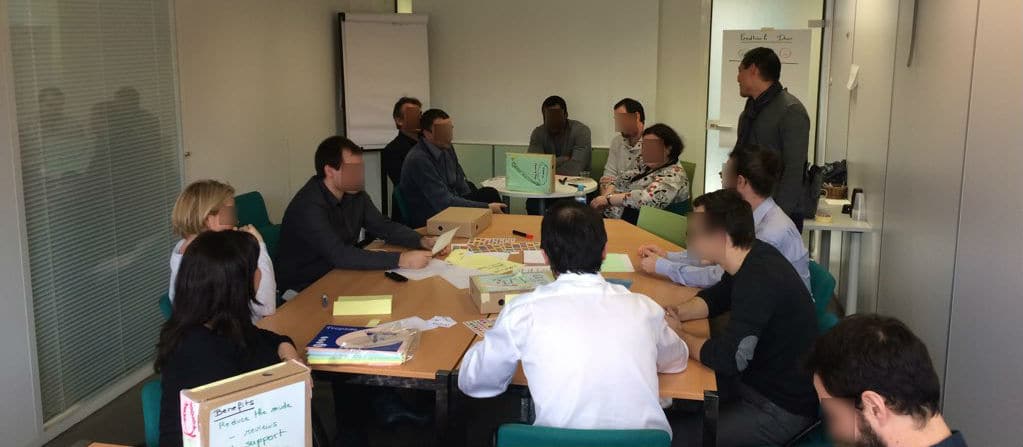
Le débriefing de l’atelier fut très court sachant qu’il ne restait plus que 5 mn. Cependant, c’est une phase inévitable de grande valeur : cela permet aux participants de prendre du recul sur l’activité et permet aux animateurs d’obtenir du feedback à leur tour.
Le retour principal était que les participants avaient pu se rendre compte que malgré l’hétérogénéité des groupes (différents métiers impliqués), des idées se retrouvaient dans toutes les boites ce qui montrait une certaine cohérence dans leur vision du présent et ce qui nécessitait de faire évoluer selon eux. De plus, le format en itération (même s’il n’y en a eu que 2) a été très apprécié de manière à pouvoir mettre en oeuvre les améliorations potentielles.
La feedback door clôtura tranquillement l’atelier. 🙂

Quelques photos des résultats

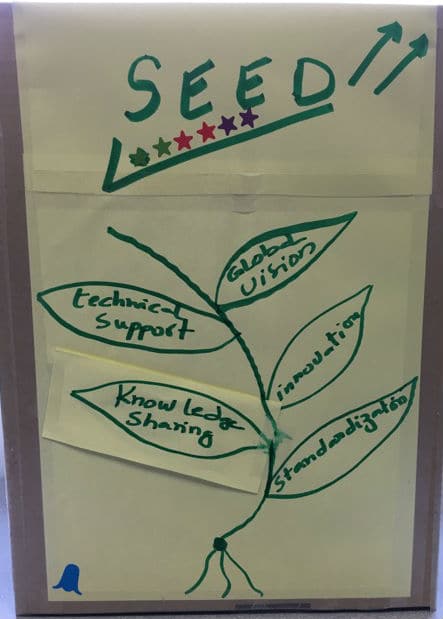
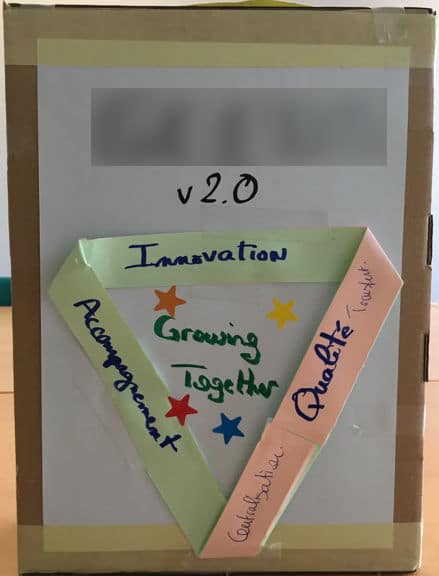
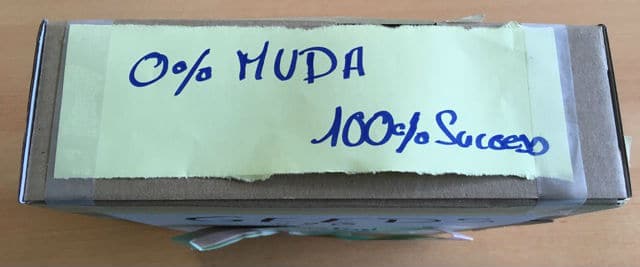

Conclusion
J’ai eu le plaisir de recevoir ce commentaire en sortant d’atelier :
En tout cas merci beaucoup Olivier de ce très bel atelier et de ce qu’il en est sorti. J’ai finalement été agréablement surprise de ce résultat, à travers un atelier jeu !
Il résume très bien ce que je voudrais partager. La vision est un élément fondamental que ce soit dans un projet de développement ou de transformation. Elle permet de donner la direction, l’horizon vers lequel le groupe souhaite se diriger. L’atelier Product Box montre bien la puissance des innovation games de « parler de sujets sérieux, sans trop se prendre au sérieux » en mettant au service des participants un cadre ludique dans lequel ils pourront échanger et débattre efficacement. Usez et abusez-en ! :-p






